Don't wanna be here? Send us removal request.
Text
Forging vs Machined Steel Bar/Plates

What is a forge?
A forge is a large hearth that has a center hole from which the smith can fire a lamp, or it can be a place where a forge is located which can heat a piece of metal to a temperature at which it becomes easier to shape by forging, or at which work hardening does not occur anymore if it is heated to a specific temperature.
In terms of size range, grain orientation strength, material use, scrap and production, and the requirement for secondary operations, machined steel bar and plate are compared and contrasted with forging – in terms of size range, grain orientation strength, and material use.
The size range of the desired material grades is as follows:
Steel bars and plates can be manufactured in many different shapes and sizes depending on the dimensions that these materials are supplied in. Forging is often the only metalworking option available with certain grades of steel and within desired sizes when it comes to steel bar and plate. A wide range of sizes of forgings can be economically produced – from parts that do not exceed 1 in in diameter to parts that have a diameter of a few millimeters. Parts that weigh more than four hundred fifty thousand pounds will also be considered.
Strength of grain orientation:
Compared to forging, machining yields a grain structure oriented to the part shape, resulting in optimum strength, ductility, and resistance to fatigue and impact, while machining cuts the grain pattern of the material. Forging yields a grain structure oriented to the part shape, and thus produces the highest strength, ductility, and fatigue resistance.
Economical use of materials:
There are several fabricating processes that are wasteful, such as flame cutting plate, which is one of several steps involved in the manufacture of a hub or a ring that requires more material than needed to make. Often times, the material cost savings are substantial, depending on whether aluminium forging, steel forge or special alloys are used. It benefits both to save on material losses in subsequent machining.
Production cost-effectiveness and scrap rate:
Steel bar and plate machining generates a lot of waste material due to the inherent nature of the machining process, so the rate of scrap is always high and the cost is always reduced. Improved material utilization, especially for near net shape forgings, results in less scrap being generated. Forgings have a decisive advantage when it comes to cost in high-volume production runs of parts.
Requirement for secondary operations:
In some grades of bar and plate, additional operations are required to remove surface imperfections, create machinability, ensure dimensional accuracy and make sure the bars and plates are strong and strong, for example by turning, grinding and polishing. In most cases, forgings can be used without the need for costly secondary operations.
For more information visit
#tronixalloys #supplier #manufacturer #forging #steel #bar #plates #forge
0 notes
Text
304 vs 304L Round Bar
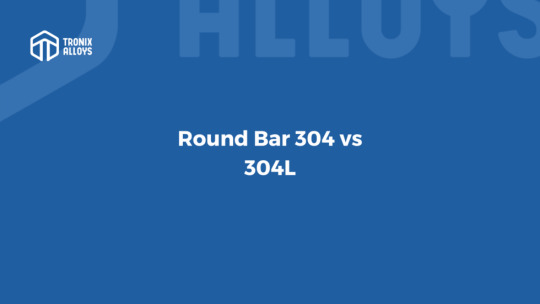
In general, 304 stainless steel round bars are used in a variety of applications, including aerospace, food and beverage, machinery, architecture, chemicals, and cryogenics. One of the most popular stainless steels on earth is 304 stainless steel, which provides great strength and good corrosion resistance outside of marine and highly acidic environments.
304 Stainless Steel has an excellent forming as well as welding characteristics, and it is suitable for use with all standard welding methods, both with and without filler materials. The 304 Stainless Steel Hollow Bar can be welded using all standard welding techniques. The Stainless Steel Flat Bar can however require a post-weld annealing process if it is heavy welded. This will ensure maximum corrosion resistance to the flat bar.
It must be noted that the 304 SS Flat Bars have been extremely durable in both a wide range of atmospheric environments as well as corrosive media. It has been proven that bars manufactured from grade 304 stainless steel are resistant to potable water containing 200 mg/L chloride at ambient temperatures, when the water is not treated with chlorine. In a temperature setting of 60 degrees Celsius, the corrosion resistance of the 304 stainless steel round bar drops to about 150 mg/L.
I would like to emphasize that the stainless steel 304 round bar has a good oxidation resistance while in intermittent service at a temperature level of 870 °C and when used continuously at 925 °C. There is no need to continuously use stainless steel grade 304 between the temperature range of 425°C – 860°C when it comes to subsequent aqueous corrosion resistance. If you have any applications where the bar is going to be heated to the temperature range mentioned above, then the low carbon content version of the SS 304 Square Bar would be a better option since it would be less likely to precipitate carbide precipitation.
The Grade 304H Stainless Steel Bar is more durable than other steel grades at elevated temperatures due to its higher strength, so it can often be used to contain pressure as well as structural components at temperatures as high as 800°C. In spite of the fact that stainless steel grade 304H will become sensitive between the temperatures range 425 °C and 860 °C, this can result in a reduced resistance to aqueous corrosion, even though this may not be a problem for high temperature applications.
For more information visit
#tronixalloys #flatbar #roundbar #stainlesssteel #squarebar #supplier #manufacturer
0 notes
Text
Top 10 SS 304 ROUND BAR APPLICATION

Stainless Steel 304 Round Bars are generally made from stainless steel material that contains approximately 18% chrome and 8% nickel, so they are exceptionally strong and corrosion resistant. They are composed of stainless steel material with a high level of strength and corrosion resistance, therefore making them extremely durable and strong. This kind of round bar is not just high strength and corrosion resistance; it also has some outstanding properties as well. In this case, AISI 304 steel serves as the base for the round bar. This metal has the minimum tensile strength to 515 MPa, while the minimum yield strength to 205 MPa. Various components made from UNS S30400 Round Bar have been successfully used on board ships to operate under high pressures and temperatures. With a melting point of 1400 degrees Celsius, UNS S30400 Round Bar is capable of operating under extreme conditions, such as extreme cold.
Its main attraction is not just the fact that the stainless steel is widely applied across a wide range of applications, but also the fact that it is extremely economical, and that is why it is so sought after. Due to its versatility and formability, and its machinability properties, Stainless Steel 304 Round Bar is easily shaped into a variety of shapes as a consequence of its formability, machinability, and formability properties. The 304 stainless steel hollow bars are increasingly popular among buyers across a wide range of industries due to their strength, corrosion resistance, and ease of processing.
Among these industries are pharmaceuticals, textiles, pulp and paper, as well as a number of others..
SS 304 stainless steel Square Bar is used in a variety of applications, ranging from pressure systems to moderately high temperatures, and many manufacturers acknowledge the fact that many businesses are able to boost their productivity as a result of using it. Combined with the right specifications, ASTM A276 304 Stainless Steel is able to outperform several carbon steel alloys in terms of corrosion resistance under moderately reducing and oxidizing conditions when used in combination with the appropriate specification.
There is no doubt that type 304 stainless steel is one of the most versatile and widely used metals. Even today, type ss304 steel is sometimes referred to by the old name 18/8 steel, which refers to the nominal ss 304 chemical composition, which is 18% chromium and 8% nickel. In ss304composition, is an austenitic grade that can be deeply drawn.
On SS 304 Round Bars, a passivated oxide layer is formed on the surface of them, which prevents corrosion as a result of oxidation. As a consequence of the free chromium present on the surface of these bars, when oxygen reacts with the 304 SS
For more information visit
#tronixalloys #supplier #manufacturer #roundbar #application #stainlesssteel #chromium
0 notes
Text
What’s the Difference Between Grade 304 and 304L Stainless Steel?
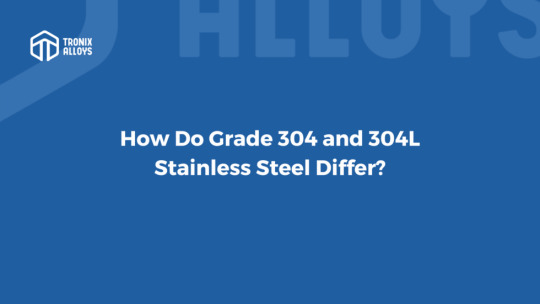
Stainless Steel Material Properties
The stainless steel market has a wide variety of grades and varieties available, but they all share common qualities such as corrosion resistance, strength, and elasticity. Each grade has a varying degree of these characteristics, but they all share these characteristics to a significant degree. It is generally accepted that stainless steel material properties are generally better in terms of corrosion resistance, ductility, strength, tensile strength, as well as cryogenic and heat toughness than standard steel.
As a result of these admirable properties of stainless steel, it is suitable for multiple applications across a variety of different industries in the manufacturing industry. However, each of these grades boasts its own unique degree of these properties, which therefore makes it suitable for applications in different fields.
With its excellent hardness, ease of maintenance, and corrosion resistance capabilities, the 300 series stainless steel is known as an austenitic steel. This stainless steel is also a popular choice for use in a wide variety of applications.
As a result of these advantages, the 300 series has become one of the most widely used and well recognized alloys in the automotive, construction, and aerospace industries. The 300 series is made from 304 alloy, which is one of the most corrosion resistant alloys on earth.
The Mechanical Properties of stainless steel and their differences
Among the other differences between grade 304 stainless steel material and its variant, grade 304L, a key difference is their mechanical properties. Grade 304L has a slight, but significant, reduction in important mechanical performance characteristics when compared to the “standard” grade 304 stainless steel material.
304L stainless steel has an ultimate tensile strength (UTS) of 85 ksi (approximately 586 MPa), less than the UTS of standard grade 304 stainless steel, which is 90 ksi (approximately 620 MPa). As shown in the table above, there is a slight difference in the yield strength of one of these materials over another, with 304 stainless steel having a yield strength of 42 ksi (289 MPa), and 304L having a yield strength of 35 ksi (241 MPa).
The result is that if you were to compare two steel wire baskets with the identical design, wire thickness, and construction, it would be safe to say that the basket made from 304L stainless steel would be structurally less reliable than the basket made from 304 stainless steel. However, the density of 304 steel is the same as the density of 304L.
For more information visit
#tronixalloys #manufacturing #supplier #stainlesssteel #differencebetween
1 note
·
View note
Text
What Is the Difference Between Steel Sheet & Plate Steel?

What is steel sheet?
Steel Sheets are any metal that is thicker than foil and thinner than six millimeters of metal plate thickness. They are frequently used to build structures that are not intended to last a long time. In addition, it is often corrugated or diamonded to add strength and thickness to it without adding additional weight to it. It can be referred to as steel sheet, or steel sheeting, which is a process in which the metal is creaked at regular intervals in order to form ridges, while diamonding is the process of adding diamonds to make the metal more dimensionally structured.
5 Advantags of Sheet Metal:
Strength and Durability
It is important to keep in mind that sheet metal is highly durable, and sheet metal parts are usually able to withstand more pressure and heat than plastic parts.
to pressure, corrosion, and wear. It is true that casting will share these advantages with plastic, but plastic won’t last as long over time.
Malleability
There are numerous advantages to using sheet metal as a construction material, including its durability and malleability. It can be bent into an array of shapes with the right equipment, while remaining strong and structurally sound. It is also capable of being compressed or stretched without breaking or cracking under the stress
Replaceability
Among the biggest advantages of sheet metal is the fact that the parts can be replaced. There is no need to replace the whole assembly if several metal parts are used in making the assembly, rather than if the whole assembly is made from a single substance.
Sustainability
Among all the materials that can be considered sustainable, metal is by far the most sustainable. In terms of environmental and economic sustainability, metal is a natural resource that is both economically and environmentally viable.
Cost-Effectiveness
Compared to cast or molded parts, sheet metal is an economical option to use because of the overall reduction in cost and waste. As a result, many companies are switching from cast of metal family to sheet metal to save on cost and waste. In evaluating the cost of material, it is also important to consider its lifespan and longevity.
For more information visit
#tronixalloys #tronix #steel #manufacturer #steelexporter #metal #iron #plate #sheet
0 notes
Text
Seamless Vs Welded Stainless Steel Pipe
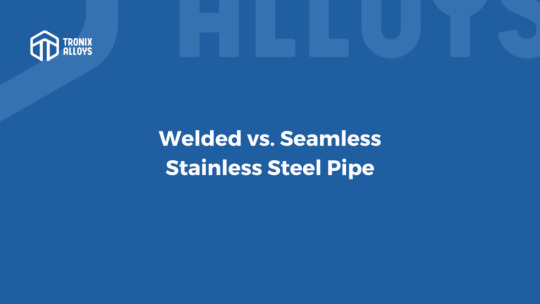
There are two common types of stainless steel tubing used in manufacturing and fabrication. The first is seamless tubing. The second is welded tubing, which is one of the most versatile metal alloys available to manufacturers. A person’s decision on whether to use seamless or welded tubing is usually determined by the product’s application requirements. In choosing between the two keep in mind that first the tubing must be compliant with your project specifications, and secondly, it must meet the conditions for which it will ultimately be used.
During the manufacturing process, seamless meaning steel pipes are manufactured by rolling the round steel billet through hot and cold rolling processes, as well as cold drawing, without a seam appearing on the body of the pipe.
Steel pipes are manufactured from flat steel plate, and the seams of the pipe are welded onto the body of the pipe. ERW pipes, LSAW pipes, and SSAW pipes all belong to this category.
In Octal, you can learn about the differences between seamless and welded pipes in terms of raw materials, manufacturing processes, performances, appearances, sizes, applications, and costs.
Historical perspectives and use cases for welded vs. seamless steel pipe
Generally, welded pipe was considered inherently weaker because it included a weld seam. Seam pipe, on the other hand, lacked this perceived structural flaw and was considered safer as a result. However, welded pipes are not considered weaker than steel pipe due to their seams, but manufacturing techniques have improved and quality assurance programs have been implemented so that as long as the tolerances of the pipe are not exceeded, welded pipe will perform as intended.
As much as seamless piping may appear to have a distinct advantage, there is no doubt that it does have some limitations in its performance due to the rolling and stretching process, which produces inconsistencies in the wall thickness as opposed to steel sheets that are destined for welding.
There is still a lingering perception that these perceptions influenced the standards for ERW and seamless steel pipe manufacturing and specification.
In the oil and gas, power generation, and pharmaceutical industries, seamless piping is required for many high-pressure, high-temperature applications. It is generally believed that plastic piping (which is generally more cost-effective and more widely available) should be specified across all industries, provided that the temperature, pressure, and other conditions are within the parameters noted in the applicable standards.
For more information visit
#tronix #tronixalloys #supplier #manufacturer #seamless #steelpipe #stainlesssteel #welded
0 notes
Text
Fabrication process of 316 Stainless Steel Pipe

What is Stainless Steel 316?
Stainless steel is a steel alloy containing at least 10% chromium, which is a corrosion resistant metal. Through the addition of chromium to stainless steel, a thin layer of metal oxide is created over the metal’s surface that protects it from the attack of corrosion-causing substances.
With a content of 16-18% chromium, 10-14% nickel, 2 to 3% molybdenum, and a small amount of carbon, stainless steel 316 is a popular stainless steel grade. When compared with other grades of stainless steel, stainless steel 316 has a greater corrosion resistance due to the presence of molybdenum. Other alloys further enhance its properties.
There are many characteristics and properties of stainless steel 316 that make it one of the two most widely used stainless steel grades after stainless steel 304. It is used in corrosive environments such as chemical plants, refineries, and marine engines. Stainless steel’s melting point falls between 2550 and 2790°F or 1400 and 1530°C. AISI 316 stainless steel has better corrosion resistance than 304 stainless steel and has good corrosion resistance in the production of pulp and paper.
Before using stainless steel tools or work surfaces that remain exposed to the environment, it is very important that they are thoroughly cleaned before use in order to prevent cross contamination of stainless steel by easily corrosion metals that could discolor the surface of the fabricated product. Fabrication of stainless steels should be done using tools specially designed for stainless steel materials. It is necessary to take these precautions to avoid cross contamination by easily corroded metals that could discolour the surface of the manufacture of the fabricated item due to their easy corrodibility.
A stainless steel 316L has a lower carbon content and it is ideal for applications where the metal might be susceptible to sensitization risks. In addition, stainless steel 316H, which is a higher carbon steel, offers greater thermal stability and creep resistance. The stabilized grade 316Ti is also widely used in stainless steel 316. In addition to being resistant to intergranular corrosion, stainless steel 316Ti is more stable than other grades of stainless steel 316.
Passivation occurs when metals take up the property of becoming “passive”, which means that they become less reactive to corrosive compounds found in the air and process fluids, causing them to become unreactive to oxidation. When stainless steel is passedivated, the surface of the steel is coated with chromium oxides that are formed by exposing it to air.
The alloy is subjected to a chemical treatment in order to enhance the formation of the passive film, where it is thoroughly cleaned by submersion of it in a bath of acidic passivation in order to enhance the development of the film of nitric acid. This layer will be created by removing contaminants, such as exogenous iron or free iron compounds, which would interfere with the process of creating a passive layer, for example.
For more information visit
#steel #pipe #manufacturer #supplier #stockist #stainlesssteel #tronixalloys
0 notes
Text
Top 10 316 Stainless Steel Pipe Applications
In the austenitic stainless steel grade, this pipe has a good range of corrosion resistance from chloride ions, as well as a good level of stress cracking resistance due to its austenitic nature. This means that the pipe can be used in marine applications and in seawater environments without any problems as a result of its properties. Pipes can be welded, seamless or electric fusion welded, and there are a wide variety of types of pipes available in the market. A 316 Stainless Steel Seamless Pipe, and 316 Stainless Steel Welded Pipe ranges in outer diameter between 12 inches and 16 inches, while welded pipes range up to 24 inches and electric fusion welded pipes range up to 100 inches in diameter. There is no difference between the strength of the 316 Welded Pipe and the 304 Welded Pipe since both types of pipes are made from strips of the same grade. In spite of this, because the pipe contains 4% molybdenum, it has an enhanced corrosion resistance. It is a member of the A312 specification for tubular products, and it can be used for applications requiring high temperatures and pressures. Pollution control, waste water purification, sea water desalination, and marine applications are the most common uses of stainless steel pipes.and marine applications.
In comparison to stainless steel alloy 304, stainless steel 316 pipe sizes offers much better mechanical properties as well as corrosion resistance as compared to stainless steel alloy 304 pipe. As a result, stainless steel 316 pipe is often used in many applications when the properties of the alloy 304 pipe are not sufficient to satisfy the requirements of the application due to the properties of stainless steel 316 pipe. Consider, for instance, the textile industry as an example. Synthetic textiles are made from synthetic materials, while natural textiles are made from natural materials. Accordingly, they are treated differently based on the type of fibre they are composed of and therefore, are processed in a different way. The fibres of cotton or linen are usually scoured and bleached in order to remove any impurities that might have been present in them before they are made into fabric.
There are a number of types of salts, soaps, or chemical solutions that are used in these processes, and if exposed to grade 304, it is certain that they would be prone to corrosion because they interact with the metal. Due to this, seamless pipes are a wonderful addition to the textile industry since they have an amazing tensile strength and highly resilient behavior, making this alloy grade an incredible addition to the textile industry. Depending on the type of fabric, textile fibres can also be dyed in a number of different ways and using a variety of chemicals, depending on the technique or chemical used. When using fibres such as nylon or silk, acids such as acetic acid are used in order to increase the rate at which dye is absorbed by the fabric, thereby facilitating the increase in colour fidelity of the fabric.
For more information visit
#tronixalloys #tronix #metal #steel #iron #supplier #manufacturer #grade304
0 notes
Text
PVC versus Stainless Steel Pipe and Fitting

There is a perception among many people that PVC pipes and fittings are less durable, less resilient, and much less long-lasting than metal materials, particularly stainless steel pipe, which is why the majority of them believe they are less durable, less resilient, and more likely to be short lived than stainless steel pipe. It is important to note that this assumption is a generalized assumption that can prove false in many real-world situations. We will discuss here the important operation characteristics between PVC and stainless steel, and show how PVC actually outperforms stainless steel on certain levels.
Comparing a plastic like PVC with a robust metal such as stainless steel may seem foolish to some, but here we will discuss the important operation characteristics between the two. It has been proven that PVC pipe and fittings can be incredibly durable, resistant and able to offer a service life that is far greater than the service life provided by stainless steel pipe fitting when used for approved applications.
Metal piping systems have been the standard method for many industrial applications for many decades. As galvanized steel, stainless steel, and other alloys are strong, durable, and capable of avecstanding the extreme temperatures and pressures of these environments, they have been made to meet the needs of all manner of industrial applications.
Additionally, a fundamental reason why metal pvc pipe systems are often specified is that they’re easy to understand and designed with a comprehensive understanding of the material’s capabilities. Engineers have acquired an intimate knowledge of the material’s capabilities, and when and how issues will arise.
A decision to change from a known to an unknown system, when dealing with industrial piping systems, is always made with an appropriate degree of reluctance, and for good reason. Any mistake could cost a company millions, and would do irreparable damage to an engineer’s reputation.
Listed below you will find nine major points with which we will compare PVC and stainless steel plumbing in terms of their respective properties, characteristics, use compatibility, service life and the costs associated with each.
For more information visit
#pvc #stainlesssteel #pipe #fittings #thesteelexporter #steelexporter #supplier
0 notes
Text
Difference Between Stainless and ERW Stainless Steel Pipe
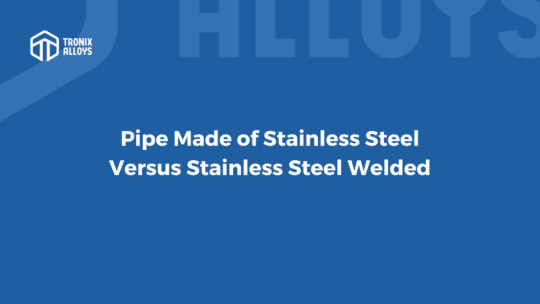
In this article, we will have a brief look at some of the differences between seamless and ERW that can have a significant effect on your application and the economics of the system.
The manufacturing process for Electric Resistance Welding (ERW) pipe involves rolling metal and then welding it longitudinally across its entire length, resulting in an ERW pipe. The seamless pipe is manufactured by extruding the metal to the desired length, as compared to the ERW pipe, which is welded at the cross-section the entire length of its length, while the seamless pipe does not have any joints at the cross-section at all throughout its length.
The seamless pipe is manufactured from solid round billets, has no joints or welding and no welding process is involved in its manufacturing. In sizes from 1/8 inch to 26 inch outside diameter, the seamless pipes are finished according to the specifications of dimension and wall thickness. High-pressure applications such as hydrocarbon industries and the oil and gas industry can be served by this product Refineries, Oil & Gas Exploration & Drilling, Oil & Gas Transportation and Air and Hydraulic cylinders, Bearings, Boilers, Automobiles etc
A ERW pipe (Electric Resistance Welded) is a longitudinally welded pipe made from a strip or coil and can be produced up to a 24″ OD length. A cold-bent ribbon of steel is used to form a tube that is fused by a series of rollers, as implied by the name, as the method is to bend the ribbon through rollers. After the tube is formed, the tube is fused with electricity. The main use of this type of pump is to transport both water and oil at low to medium pressures. ERW Steel Pipe is available in a wide range of lengths from 2 3/8 inches in diameter to 24 inches in diameter, including lengths over 100 feet in length. The surfaces of the building can be finished in a variety of ways, including in bare or coated formats, and processing can be handled on site according to the customer’s requirements, depending on the specifications.
When it comes to manufacturing seamless and ERW pipes, what are the technologies that are used?
The production of seamless steel pipes and tubes up to seven inches OD is one of the most renowned technologies in the world today. This technology is referred to as “plug mill” and it is used for larger diameter pipes. Seamless Pipes and Tubes Manufacturing from 7-inches to 14-inches, is the most reliable technology when it comes to higher diameters. Our ERW Pipes & Tubes up to 21-inches OD are welded with high frequency induction welding technology.
For more information visit
#stainlesssteel #erwstainlesssteel #pipe #tronix #tronixalloys #steelexporter #supplier
0 notes
Text
What’s the Difference Between Steel Pipe and Steel Tube

A hollow section of steel with a round cross-section has been manufactured in the United States since the early 1800s. It is made for the transportation of a wide variety of products, including fluids, gas, pellets, powders, and more. There are many uses for steel pipes, including underground transportation of water and gas, construction to protect electrical wires, and even the transport of liquids and gases. Steel pipes are not only strong, but they also can be lightweight. In addition to this, they are also used for making parts for automobiles, refrigeration units, heating and plumbing systems, flagpoles, and street lamps, just to name a few. This makes them ideal for bicycle frames and other products.
The most important dimension for a pipe is the outer diameter (OD) along with the wall thickness (WT). By subtracting the outer diameter from the wall thickness (WT), the inside diameter (ID) of a pipe is determined, and the amount of liquid it can hold. When we talk about pipe in our industry, we often refer to the pipe as a schedule (ID), such as 2 inches schedule 40 or 14 inches extra heavy. This is what the industry refers to as a pipe. For instance, we can use the walls or schedules below, including the standard (STD), and the XS/XH. The majority of pipe is sold in lengths of 21 or 42 feet, depending on the manufacturer.
What is Tube?
In engineering, a tube refers to hollow sections that are shaped like rounds, squares, rectangles, or ovals. The tubes are used for pressure equipment, mechanical applications, and instrumentation applications.
There are several raw materials used to make steel tubing, including iron, carbon, manganese, vanadium, and zirconium. Seamless tubing can also be welded, while welded tubing is a solid block of steel that is rolled into a round shape and pierced and stretched to its final length. The same thing is done to play dough when you roll it into a cylinder. If you have extra dough, push your finger through the middle and stretch it out to make it longer. It is produced in the same way, but the raw materials are hot and spinning, and everything is completely machine operated. A welded steel tubing, on the other hand, is made from coils of steel that are welded together. Initially, the coil is slit and rolled up into a round shape, then welded together at the ends. As a result, the tubing can either be simply cut to a certain length and used as round tubes, or it can be altered into other shapes such as square, rectangular, oval, etc. based on the location of the tubing.
It is common for buyers in our industry to refer to the item they are considering as an (OD) and a (WT) in inches or millimeters. The outer diameter (OD) and the wall thickness (WT) of the tube are indicated in inches or millimeters. Tubes can be purchased in a variety of wall thicknesses, such as 11 gauge, 1/4″, 3/8″, or 5/8″. They are available in lengths of 20, 24, 40, and 48 feet, but they can also be manufactured in custom lengths.
For more information visit
https://tronixalloys.com/whats-the-difference-between-steel-pipe-and-steel-tube/
#differencebetween #steel #pipe #steeltube #steelexporter #thesteelexporter #supplier
0 notes
Text
Difference Between 316 and 302 Pipes
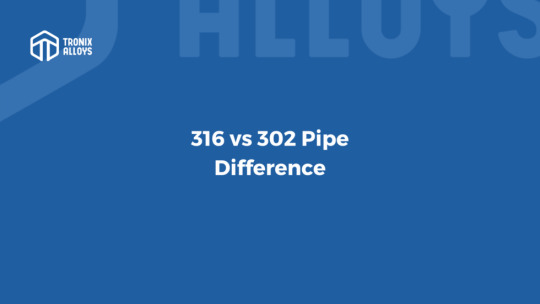
What is stainless steel?
As with all steels, stainless steel contains the same basic iron and carbon composition as other steels, but stainless steel also contains a healthy dose of chromium that gives this alloy its salt corrosion resistance fame.
The term stainless steel describes a group of materials with a slightly different alloy composition, which is responsible for the slightly different physical characteristics of each of these materials.
Chromium must be at least 10.5 percent in stainless steel. It may also contain other alloying elements that can be much higher in concentration, such as molybdenum, nickel, titanium, aluminum, copper, nitrogen, phosphorous, or selenium, depending on the grade.
Common stainless steels
Most stainless steels are made from 302 and 316 grade stainless steel. The main difference between the two grades is the addition of molybdenum, which enhances corrosion resistance very significantly in salt- and chloride-exposed environments.
302 Stainless Steel
There are many types of stainless steel, but the most common is 302 stainless steel, which is used worldwide because of its excellent corrosion resistance and low price. It contains between 16 and 24 percent chromium and up to 35 percent nickel, as well as minor amounts of carbon and manganese.
The most commonly used form of 302 stainless steel is 18-8 (18/8) stainless steel. This has an 18 percent chromium content as well as an 8 percent nickel content.
Due to its excellent corrosion resistance and value, 302 is the most common type of stainless steel used throughout the world.
It is widely used in food processing and kitchen applications, and it is also commonly found in buildings, décor, and site furnishings. 302 can withstand corrosion from most oxidizing acids, so it is easy to sanitize.
The 302 ss does have one weakness: it can be corroded by chloride solutions, or by salty environments like the seashore. The corrosion caused by chloride ions can spread beneath protective chromium barriers and compromise internal structures, resulting in pitting. The corrosive effect of sodium chloride can begin as little as 25 parts per million.
316 Stainless Steel
The 316 grade is the second-most commonly used grade of stainless steel. 316 stainless steel is nearly identical to aisi 302 stainless steel in terms of physical and mechanical properties, and contains the same material composition as 302 stainless steel. A key difference is the addition of molybdenum to the 316 stainless steel, which increases corrosion resistance, particularly in the presence of chlorides.
The molybdenum in 316 stainless steel provides resistance to chlorides and other processing chemicals.
Many industrial applications that involve processing chemicals and in high-salt environments such as coastal regions and outdoor areas where deicing salts are used are commonly made of 316 stainless steel. Since 316 stainless steel is non-reactive, medical surgical instruments are also manufactured from it.
In alternative 300-series grades, molybdenum can amount to up to 7 percent. These grades provide better chloride resistance, but such heavy-duty resistance should only be needed in industrial and high concentration exposure conditions.
For more information visit
#differencebetween #316 #302 #pipes #stainlesssteel #tronix #tronixalloys #steelexporter
0 notes
Text
Difference Between 316L and 304L Pipes
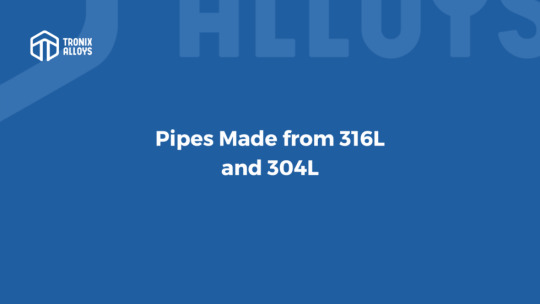
What is Stainless Steel?
Iron is one of the softest elements in the universe. Adding up to 2% of carbon to steel, which is now known as steel, gives it incredible strength, hardness, and mechanical properties, all of which are a result of its carbon content. A lot of people use steel due to the abundance of iron and its easy and cheap availability, as well as the fact that steel is also very flexible. However, steel also has a weak spot, which is found in the iron that is used in steel products. Oxidation, or rusting, is a natural process that occurs to metal over time. As a result of oxidation, rust forms.
A chemical reaction occurs when an element is combined with oxygen, resulting in oxidation and corrosion, which takes place on the surface of the metal when oxygen is combined with all elements in nature. The corrosion process forms a very thin layer on the surface of the element, which, once this layer has formed, acts as a protective layer, preventing the material from contact with the air and preventing rust from developing. As a result of this thin layer of protection, the color of the metal hardly changes as the element of iron does. In contrast, the element is not the same as this.
The difference in size between the iron and oxygen atoms causes the iron mineral to fail to form a solid bond at its surface, and this coupled with the penetration of rust into the iron element over time means that iron loses all its strength over time, due to the difference in the size of the iron and oxygen atoms.
Chromium’s small atoms combine very easily and rapidly with oxygen because the atoms are so close to each other. As a result of the combination with oxygen, chromium forms a very thin but very strong layer. This layer is not reacted to by any other reaction. Even if it is damaged, the layer reappears in a few weeks. When chromium is added to steel at a certain rate, the same thing happens: the steel will no longer rust. Stainless steel is obtained by combining more than 10% of chromium with iron and carbon.
Advantages Of Stainless Steel
The ease of manufacturing majority of stainless steels can be formed with cutting, welding, cold and hot forming, and machining techniques, enabling them to be used in most applications.
Mechanical Strength
The majority of stainless steels are strengthened by cold forming, and thanks to the increase in strength, it is possible to reduce the thickness of the material in designs, thereby reducing the weight and price of the part. It has been shown that heat treatments can provide a material with a high degree of strength in certain species.
Hygienic Feature:
In hospitals, kitchens, food, and pharmaceutical industries, stainless steel material is widely used because of its easy cleaning ability.
For more information visit
#differencebetween #316L #304L #pipes #steelexporter #thesteelexporter #supplier #stockist #manufacturer
0 notes
Text
304 Seamless vs Welded pipes
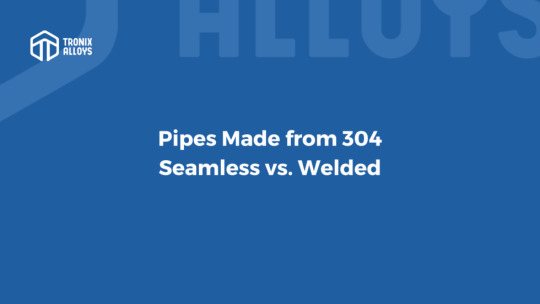
There are many methods of making seamless steel pipe. One of them is the use of billet steel. As the steel is heated and pushed or pulled over a form, it is molded into a hollow tube. Seamless pipes can come in many different sizes and schedules. Nevertheless, there is no manufacturing of large diameter seamless pipes. However, seamless pipes are commonly used as pipe fittings, such as bends, elbows, and tees. Since a seamless stainless steel tubing has no seams, it is able to withstand high temperatures equally, whereas a pipe with seams is generally weak at the spot of welding. As a result, the seamless steel tube can withstand high pressures equally at its entire diameter.
There are two types of seamless steel pipe, namely, the solid steel pipe and the hollow tube. The seamless steel pipe is an integral tube with one end attached to another, without any welding joints. The seamless pipe has threads at either end of it, but they can also be threaded to both ends of a hollow tube or pipe. It is important to note, however, that since seamless pipes lack the welding line, they can stand up to the weight they carry and remain intact. It is well known that seamless pipes are widely used in a range of commercial applications because of their strength and anti-bending properties, and not only in oil fields, but also in shipbuilding, offshore drilling rigs, pressure vessels, manufacturing, chemical industries, and other industries.
Stainless Steel Pipes of various grades can be found in the industry today. A few of the most commonly used Stainless Steel Grades are Stainless Steel 304 Pipes and Stainless Steel 316 Pipes. There are two types of Stainless Steel Pipes in the industry today. These pipes are available in both Seamless and Welded forms. There are many applications where stainless steel pipes 304 can be used, for example in industries that require high corrosion resistance. Stainless steel welded pipes 316 are generally used in marine industries.
A Welded / Electro-resistance Welded pipe is made by cold forming a steel coil into an elongated cylindrical tube. This is done by using a machine to bend the steel coils into a circular shape. As part of a continuous phase, the first plate or coil is rolled into a circular section with a plate bending machine or by way of a roller, creating a welded pipe. In the event that a circular segment of the pipe is rolled from the plate, the pipe can then be welded using filler material or not. It is possible to produce welded pipes in large sizes without having to worry about the upper limits. As a result of the use of welding with filler material, long radius bends and elbows can be produced using welded pipe. Since welded pipes are cheaper than seamless pipes, they are also weaker due to the fact that they are welded together.
For more information visit
#304 #seamless #welded #pipes #coils #steelexporter #tronix #tronixalloys #supplier
0 notes
Text
Seamless Vs Welded Stainless Steel tubing?

What Is Seamless Stainless Steel Tubing and What Are the Advantages?
It is necessary to have a mechanism in order to force a hole into a billet in order to make seamless tubing. Seamless tubing does not have a longitudinal weld seam. The seamless meaning pipe is manufactured without welding at any stage. When welding pipe, no filler is added during the welding process.
As a result, rotary piercing and rolling are considered to be the most popular method today for manufacturing seamless tubing. It is the process of heating, piercing, and working a steel round bar that has been conditioned. As the tube is forced to flow around a piercer point, it creates a hollow billet which is supported by a mandrel or plug, while the billet roller is extended. Additional rolling on the outside diameter of the steel tube is required to size it.
In addition to this, seamless tubing can withstand a pressure up to 20% higher than welded tubing of the same material and size due to the absence of welded seams. Welded and drawn tubing may also have visible seams that can be a problem for the user.
Asst tube is able to provide superior corrosion resistance thanks to the fact that it does not contain any impurities, which is one of the advantages of seamless tubing. It is possible to avoid defects and differences in malleability that may occur in welded tubes if you choose seamless tubing instead of welded tubes. There is a large difference between seamless steel pipe and welded tubes because
seamless tubes do not require testing for the integrity of the weld, unlike welded tubes.
Therefore, seamless pipe is often more suitable for critical applications.
What Is Welded Stainless Steel Tubing and What Are the Advantages?It is the first step in the production of a welded tube to roll a steel coil to a thickness that corresponds to the desired gauge thickness. The strip is then rolled into a coil, then cut into a width that corresponds with the size of the tube that needs to be produced. After this is completed, the coil of the flat strip is formed.
In order to form a tube, a cut coil is passed through several rollers, and then the tube is then welded in a chemically neutral environment during a rolling process. In order to forge the welded seam in the tube, a rolling process is used, followed by a heat treatment process in order to finish the welded tube. As soon as the tubes have been welded together, they can be drawn over mandrels and ground if necessary so that the welded seams are smoothed and make it almost impossible to observe from a distance.
For more information visit
#seamless #welded #stainlesssteel #tube #steelexporter #thesteelexporter #steel
0 notes
Text
What is Welded Steel Pipe

A welded steel pipe is constructed from a flat steel plate or a flat steel strip, and the manufacturing process results in a seam on the pipe’s surface. For welded steel pipes, the steel plate or strip must be bent and then welded into either a circular, traditional pipe shape or a square shape as part of the manufacturing process. There are three types of welded steel pipes: LSAW pipe, SSAW pipe, and ERW pipe. Each type is categorized based on the way in which the pipe is welded. There are two types of welding techniques used in pipes, LSAW and SSAW. LSAW pipes are longitudinally welded, while SSAW pipes are spirally welded. ERW pipes are electric resistance welded, which results in a seam that runs parallel to the pipe body.
There are many types of welded steel pipe, but all of them are quick and easy to produce. Moreover, they tend to be cheaper than their alternatives, such as seamless steel pipe, which occupies more space and costs you more money. Overall, welded stainless steel pipe is an affordable, adaptable material that can be used for a wide variety of projects.
As the name suggests, welded pipe (i.e. pipe that is manufactured with a weld) is a tubular product that is manufactured from flat plates called skelps, which are formed, bent and prepared for welding, with a longitudinal seam weld being the most common method for large diameter pipes.
A spiral welding process is an alternative method for making pipe with large diameters from narrower plates or skelps, as well as using spiral welding as a construction method. As with longitudinally welded SAW pipe, spiral welded pipe joint may also experience defects associated with the SAW weld. This defect is similar to the defects experienced by longitudinally welded SAW pipe in its nature.
A high frequency induction (HFI) is a welding process that produces electrical resistance weld (ERW) and high frequency induction (ERW) pipe. Originally, this type of pipe was manufactured by resistance heating to make the longitudinal weld (ERW), which is composed of a solid phase butt weld. Although the majority of pipe mills now use high frequency induction heating (HFI) in order to improve quality control and consistency, the product is still commonly referred to as ERW pipe, even though the weld may have been produced using the HFI/HFW (High Frequency Welded Pipe) method.
For more information visit
#welded #steel #pipe #tronix #tronixalloy #supplier #manufacturer #steelexporter
0 notes
Text
316 Stainless Steel Pipe vs 316L Seamless Pipe
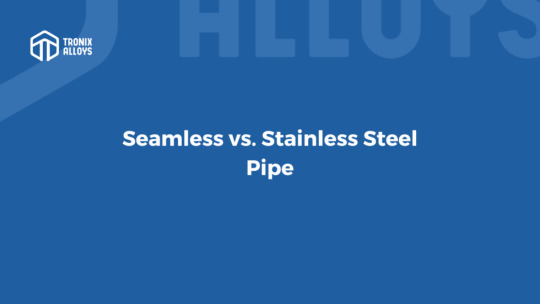
What is 316 Stainless Steel Pipe?
It is a steel tube made of molybdenum, chromium, and nickel alloy with molybdenum added to it. The material is highly wear-resistant and corrosion-resistant compared to the ordinary 304 steel material, due to its high wear-and-tear resistance, strength, and corrosion resistance. A stainless steel tube of the gra 316, which is high-quality stainless steel, is ideal for applications requiring high strength and corrosion resistance. Stainless steel 316 is the world’s second most widely used grade in the world. Because of its resistance to corrosion and stress cracking caused by chloride ions in chloride ion networks, stainless steel 316 tubings are employed in a wide range of applications in some of the most important industries such as food processing, marine industry, seawater processing, nuclear power plants, heat exchangers, and boilers. Because of this, this material can survive in environments with a high concentration of chloride ions.
Benefits of 316 Stainless Steel
Stainless Steel 316 is not only excellent for its durability, but it also has a number of other advantages, including the following:
It retains its strength at elevated temperatures for a longer period of time than Type 304 steel
In addition, it is weldable to a high degree of precision
The machinability of this material is excellent
There is a good level of corrosion resistance with this product
A high level of resistance to pitting is provided by this material
Due to its austenitic structure, it is very tough even at cryogenic temperatures, which is why it is so widely used
Potable water is not considered to be a concern for the material
Superior resistance to chloride is one of its most important attributes
Molybdenum adds corrosion resistance to the metal, which can withstand acetic, sulfuric, and sulfurous acids as well as other industrial chemicals. Inks, textiles, photographic chemicals, papers, textiles, rubber, and bleaches are some of the products made with these types of corrosive process chemicals.
– Stainless Steel 316 has superior resistance to corrosion, cracking, and pitting. This stainless steel offers a reduced risk of stress corrosion cracking, improved creep resistance, as well as better resistance to pitting and crevice corrosion than other stainless steels.
There are several types of stainless steel that are used in the pulp and paper industry to avoid iron contamination of the product; Type 316 is one type that is commonly used in the paper industry.
What is a 316L Seamless pipe?
These austenitic stainless steels are similar to 304 and 304L, except with the addition of molybdenum. 316L seamless stainless steel tubes are composed of 316 material and have a low carbon content. In chloride environments, molybdenum improves corrosion resistance, particularly pitting and crevice corrosion resistance.
For more information visit
#stainlesssteel #pipe #seamless #316vs316L #steelexporter #supplier #tronix #tronixalloy
0 notes